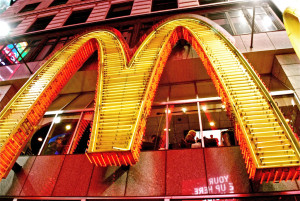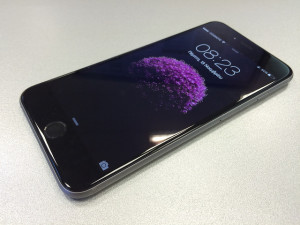By Peter Ward July 24, 2015
Nikkei to Buy Financial Times for $1.3bn
The Financial Times newsroom ©Adam Tinworth
Publishing group Pearson agreed to sell The Financial Times Group to Japanese media company Nikkei for $1.3 billion on Thursday.
Reuters initially reported on Thursday morning that Pearson had decided to sell the famously pink-paged Financial Times after years of speculation. That story prompted a flurry of reports and speculation as to the identity of the buyer.
The Financial Times’ own reporters ran a story claiming German publisher Axel Springer had bought the newspaper. But hours later Pearson released a statement confirming that the Financial Times Group, which includes FT Labs, How to Spend It, Money-Media and other publications, was to be sold to Nikkei in an all-cash deal.
Pearson’s 50% stake in The Economist and the London headquarters of the Financial Times are not part of the deal. Pearson made the sale in order to concentrate on its education business, Chief Executive John Fallon said in a statement.
“Pearson has been a proud proprietor of the FT for nearly 60 years. But we’ve reached an inflection point in media, driven by the explosive growth of mobile and social. In this new environment, the best way to ensure the FT’s journalistic and commercial success is for it to be part of a global, digital news company,” Fallon said. “Pearson will now be 100% focused on our global education strategy.”
Last year the FT group contributed $334 million in sales and $24 million in adjusted operating income to Pearson. The deal is expected to be completed in the fourth quarter of 2015.
McDonald’s Continuing Sales Slump

McDonalds arches, Times Square. ©Miguel Vaca
Fast food giant McDonald’s recently revived promotional character the Hamburglar in an attempt to arrest declining sales. But the hipster icon failed to produce the desired effect, as the restaurant chain reported a drop in U.S. sales for the seventh straight quarter on Thursday.
McDonald’s profit declined from $1.39 billion a year earlier to $1.2 billion, a drop of 13%. Sales in U.S. locations also fell by 2%. The company’s total revenue of $6.5 billion did beat Wall Street expectations of $6.45 billion, however.
McDonald’s has launched a number of initiatives in 2015 aimed at improving sales. The company announced an all-day breakfast menu, launched a customer complaint app in Japan, stopped selling chicken raised with antibiotics and allowed customers to build custom burgers.
CEO John Easterbrook, appointed in January, said global sales are expected to be positive in the third quarter. Income for the second quarter in Europe did rise 1.2% but fell by 4.5% in Asia, the Middle East and Africa. The CEO claimed that some of the new ideas were starting to gain traction, although admitted the second quarter results were disappointing.
Lockheed Buys Maker of Black Hawk for $9bn
Lockheed Martin, the world’s largest defense contractor, announced the acquisition of Sikorsky Helicopters for $9 billion in cash on Monday. Sikorsky Aircraft, the U.S. manufacturer of the Black Hawk helicopter, is a division of United Technologies.
The effective cost of the deal is around $7.1 billion, according to Lockheed, as the transaction will be structured as an asset purchase, resulting in a tax benefit of $1.9 billion.
Sikorsky’s most recognized aircraft is the Black Hawk, but the company also manufactures the Seahawk and Marine One fleet, used to transport the U.S. president. Last year Sikorsky won a $1.2 billion contract to build the next fleet of Marine One helicopters.
Lockheed also announced $6 billion in its own services and businesses are under review for potential sale or spin-off. Both moves mark an organizational shake up by CEO Marillyn Hewson. Reuters hailed the deal as a turning point for Hewson as she grows more assertive in her role. Hewson, number four on Forbes’ list of most powerful female executives, was appointed to the position in January 2013, after the intended successor to the retiring Robert Stevens was fired for having an affair with an employee.
Apple Shares Tumble Despite Profit

iPhone6 © John Karakatsanis
Investors poured scorn on Apple’s impressive quarterly report on Wednesday, sending the company’s share price tumbling despite an impressive boost in quarterly profit.
Apple’s earnings report revealed a 38% rise in profits to $10.7 billion for the third quarter of 2015, and a 33% rise in revenue to $49.6 billion.
But investors were unimpressed with the company’s revenue forecasts, and shares closed at 4.3% lower than prior to the results being announced. Apple forecasts revenue between $49 billion and $51 billion for the fourth quarter of the year.
Analysts also believed the loss of investor confidence was partly due to the company’s over-dependence on the iPhone, the BBC reported.
The Cupertino, California-based company sold 47.5 million iPhones in the third quarter, up 35% from the same period a year earlier. Mac computer sales also rose, 9% to 4.8 million.
Imploding Markets: Comparing China to History’s Big Crashes
Shanghai stock market banner © calwhiz
On Wednesday Quartz published a fascinating comparison of China’s seemingly inevitable stock market disaster with Wall Street’s crash in 1929 and Japan’s fall from grace in 1989.
Reporter Gwynn Guilford notes a number of similarities between China’s issues now and those suffered by the U.S. before the crash in 1929. Both situations involved booming GDP, consumer optimism, easy credit and a stock market surge. Other similarities include an increase in margin trading and something called “pyramiding,” a kind of multi-layered shareholding through complex investment trusts, which can amplify both gains and losses.
Punctuated by helpful graphics and an exceptionally clear explainer video, Guilford’s article then makes a case for comparing China’s problems to those of Japan in 1989. Japan’s investment-led growth model, state dominance and declining corporate profits all led to a financial crisis which lasted until the mid-2000s.
The long term effects of the U.S. and Japan crashes were different. The U.S., which did little to counter the effects of the crash, entered a decade-long depression with devastating results, but did eventually recover. Japan on the other hand did everything it could to prevent banks and companies from going bankrupt, and is still suffering from the subsequent levels of debt it is piled under.
The article concludes that although the situation in China does bear some resemblances to the Wall Street crash in 1929, the reaction of the Chinese government is likely to be far more similar to that of the Japanese in 1989.
This entry was posted on Friday, July 24th, 2015 at 11:34 am. It is filed under Week in Review and tagged with Apple Inc., Chinese stock market, iPhone, Lockheed Martin, Sikorsky. You can follow any responses to this entry through the RSS 2.0 feed.
Comments are closed.
